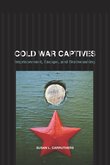Susan L. Carruthers,
Cold War Captives: Imprisonment, Escape, and Brainwashing.
California: University of California, 2009.
ISBN: 9780520257313
US$21.95 (pb)
352pp
(Review copy supplied by University of California Press)
A professor in the Federated Department of History at Rutgers University, Susan L Carruthers’ research on American and British 20th century history focuses on the relation of media to conflict and war. Her previous publications include, The Media at War: Communication and Conflict in the Twentieth Century (2002) and Winning Hearts and Minds: British Governments, the Media and Colonial Counter-Insurgency 1944-60 (1995). More recently, she has turned her attention to the contemporary phenomenon of the Iraq war film, taking a particular interest in documentaries. Cold War Captives: Imprisonment, Escape, and Brainwashing foregrounds her interest in media, conflict and popular culture in what is an exemplary study of this pivotal moment in the history of American cultural and political life.
Meticulously researched and impressive in its breadth, Cold War Captives draws on official government documentation, tabloid press, cartoons and Hollywood movies to develop a rich and provocative cultural history of this period. While the American cold war has received much scholarly attention, Carruthers’ work traces an alternative path, pursuing the “rhetorical oppositions between slavery and freedom” (p. 21) that took shape around actual struggles over repatriation, forced labour, defection, imprisonment and mind control.
Carruthers first captures the reader’s imagination with the story of Oksana Kasenkina’s “leap for freedom” from the upper story of the Soviet Consulate in New York City on the 12th August 1948. She poses that it was at this point that the cold war became “emotionally resonant for ordinary Americans” (p. 3). As the title Cold War Captives suggests, Carruthers places the binaries of slavery and freedom at the centre of her investigation into cultural and international politics in an effort to understand “what it meant to Americans to be engaged in a cold war”(p. 22), and why and how this conflict frequently found expression in the metaphor of captivity. While acknowledging that the genre of captivity has a tendency to resurface at times of insecurity, she argues that the American cold war imaginary was informed by a dichotomy between mobility and captivity, between human slavery and human freedom.
With America portraying itself as the “free world” and with its population convinced that communism shackled its people, confinement under communist domination was portrayed as monstrous. Carruthers notes that during the 1950s while departures from the Eastern block declined sharply, the Iron Curtain, in the Western imagination, became less penetrable, fed by tabloid headlines of daring escapes. Hollywood further helped to generate the idea of “the free world” as desirable through its portrayals of a culture of glamour, sophistication and consumption, while also helping to contribute to the stock representations of escapees as seen, for example, in Elia Kazan’s Man on a Tightrope (USA 1953), Ralph Thomas’s The Iron Petticoat (UK 1956) and Howard Hughes’s Jet Pilot (USA 1957).
The “diabolical techniques” of brainwashing become fodder for fantastic media coverage, given headline attention with the arrest in Budapest of U.S. businessman Robert Vogeler as a traitor, and the sentencing of Cardinal Mindszentry, as a spy. While the American public could accept Vogeler’s full confession in a Budapest court in 1950 and the regime’s declaration of his impassioned contrition, Carruthers claims they were unwilling to believe that Mindzsentry, a staunch anti-communist, would ever, in his right mind, denounce his actions. The unease around the regime’s ability to “break” the tough Catholic cardinal and images of him on trial looking “otherworldly” helped to compound the fearful idea that the communists had sophisticated techniques for “mind control”.
Turning her attention to the Korean War, Carruthers suggests that what most Americans recall about this conflict “wasn’t Washington’s stand on repatriation but their prisoners’ wholesale collapse in captivity” (p. 216). Attempting to understand why twenty-one young American soldiers refused to be repatriated, she observes:
Early cold war America was indeed increasingly affluent, but amidst the ‘people of plenty’ millions still lived in poverty….Nearly all of the nonrepatriates had grown up poor, some in utter destitution.
…Gothic flourishes aside, these stories of broken homes, impoverished childhoods, and truncated educations failed to mark the twenty-one as distinct from their military peers. On average, the American GI who served in Korea possessed eight and a half years of schooling. Forty-four percent had only a grade-school education, and among both captives and casualties in the Korean War, African Americans were disproportionately represented. (pp. 213-214)
Flash-forward to the current Iraq War and it seems that little has changed. The status of the American GIs who fought in the Korean War has a strong resonance with current military recruits. Within a decade most of the soldiers who refused to be repatriated did return home. However, Carruthers suggests that the shame felt about the mental collapse of imprisoned Americans and some GIs’ refusal to be repatriated resulted, as the cold war progressed, in the development of a national preoccupation with a perceived susceptibility to manipulation. What became know as the POW “collapse thesis” led to the military’s attempts to fortify the national character of “American boys”. (p. 206) Part of this innovation involved “torture schools”—camps where recruits were placed on mock death-marches, forced to spend extensive periods of time in sweat boxes, given electric shocks by their peers and deprived of sleep.
Since September 11, 2001, Carruthers claims we have seen the mobilization of traces of cold war strategies and imaginary, with the “harsh interrogation” techniques uncovered at Guantanamo Bay, Cuba, Bagram Air Base in Afghanistan and Abu Ghraib prison in Iraq. In conclusion she argues that these actions are a direct outgrowth of America’s encounter with communist captivity in the late 1940s and early 1950s. The “torture schools” confront us with a chilling reminder of America’s wiliness to brutalise its own military forcec; the ramifications of these extreme and inhuman actions are surely not surprising.

